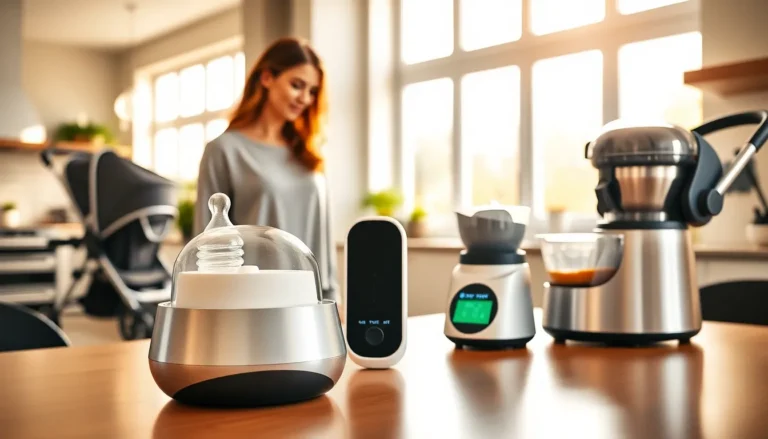Dealing with impacted stool can feel like a scene from a horror movie—except the villain is stuck right in your gut. It’s uncomfortable, embarrassing, and let’s be honest, nobody wants to talk about it. But fear not, because relief is within reach! Understanding how to manually remove impacted stool might just turn you from a victim of constipation to a champion of your own digestive health.
Table of Contents
ToggleUnderstanding Impacted Stool
Impacted stool involves a blockage in the intestines, making bowel movements difficult or impossible. Knowing the causes and symptoms assists in identifying and addressing this condition effectively.
Causes of Impacted Stool
Dehydration frequently contributes to stool hardening. Lack of dietary fiber can lead to irregular bowel movements, causing stool to accumulate. Certain medications, such as opioids, slow down bowel activity. Medical conditions like diabetes or hypothyroidism may also impact digestion, increasing the risk of constipation. Sedentary lifestyles often reduce bowel movement frequency. Aging brings changes in digestive health, making older adults more susceptible to impacted stool.
Symptoms of Impacted Stool
Abdominal discomfort often signals impacted stool. Straining during bowel movements is common and may occur alongside infrequent passing of stool. Nausea and loss of appetite can indicate problems in digestion. An overly full feeling in the rectum may cause distress. People may experience bloating as a result of gas buildup. In severe cases, individuals might face vomiting or fever, necessitating medical attention. Observing these symptoms helps in early identification and prompt management of the condition.
Preparing for Manual Removal

Preparation is key for effectively managing impacted stool. Understanding the situation and gathering the right supplies promotes safety and efficiency during the process.
Assessing the Situation
Start by identifying symptoms and understanding their severity. She should evaluate abdominal discomfort levels and note any straining during bowel movements. It’s important to consider previous bowel movement patterns. If she experiences severe discomfort, nausea, or vomiting, seeking medical assistance becomes essential. Recognition of the situation also includes understanding lifestyle factors contributing to constipation. Observing these aspects can guide the decision-making process regarding immediate intervention.
Gathering Necessary Supplies
Gathering supplies simplifies the manual removal process. Items needed include gloves, lubricant, and a soft cloth or towel. Gloves protect hands from bacteria and make the process more hygienic. Lubricant, such as mineral oil or water-based gel, eases the removal of stool and reduces discomfort. A soft cloth provides comfort and cleanliness before and after the procedure. Ensuring all supplies are within reach makes the task more manageable. This preparatory step promotes effective intervention and enhances comfort during the process.
Step-by-Step Guide on Manual Removal
Manual removal of impacted stool requires careful steps to ensure safety and effectiveness. This guide outlines key techniques to facilitate the process.
Positioning the Patient
Select a comfortable and private area for the patient. Proper positioning promotes relaxation and facilitates easier removal. Lying on the left side with knees drawn toward the chest can maximize access and comfort. Alternately, a semi-reclined position may work better for some individuals. Support the patient’s back with cushions to maintain stability. Ensure that the environment remains calm to reduce anxiety during the procedure. It’s crucial for patients to feel secure to permit a smoother process.
Techniques for Manual Removal
Begin with applying lubricant to the gloved fingers. This step minimizes discomfort during the removal process. Gently insert one fingertip into the rectum, carefully feeling for the impacted stool. Employ slow, deliberate movements to break up any solid masses. If resistance occurs, cease forceful attempts. Instead, adopt a gentle rocking motion to gradually encourage stool movement. The goal is to gradually and calmly expel the impacted matter. Use soft, consistent pressure while continually assessing the patient’s comfort level during the process.
Aftercare Post-Removal
Aftercare is essential in managing health after manually removing impacted stool. Attention to monitoring and prevention enhances recovery.
Monitoring for Complications
Monitoring for complications is crucial after the removal process. Watch for signs like persistent abdominal pain, bleeding, or fever. Any of these symptoms may indicate potential complications. It’s important to reach out to a healthcare professional if any of these arise. Keeping hydrated plays an essential role in recovery, as dehydration can worsen symptoms. Increased fatigue may also suggest a need for medical evaluation. Regular check-ins with a healthcare provider help ensure a smooth recovery and prevent future issues.
Tips for Preventing Future Impacted Stool
Preventing future impacted stool requires proactive measures. Maintaining a high-fiber diet is beneficial, as it promotes regular bowel movements. Drinking sufficient water each day helps soften stool and supports digestion. Regular physical activity enhances intestinal motility, making it easier to avoid blockages. Establishing a routine for bathroom visits encourages healthy bowel habits. Monitoring medication side effects is also important, as certain medications can contribute to constipation. Using stool softeners or gentle laxatives, when necessary, can provide additional support.
Addressing impacted stool can feel daunting but taking proactive steps can lead to effective relief. By understanding the symptoms and preparation needed for manual removal, individuals can regain control over their digestive health. The techniques outlined provide a clear path to safely manage this condition, while aftercare plays a crucial role in recovery.
Preventing future occurrences is equally important and involves lifestyle adjustments such as improved hydration and dietary choices. By staying informed and proactive, individuals can avoid the distress of impacted stool and maintain a healthier digestive system.





